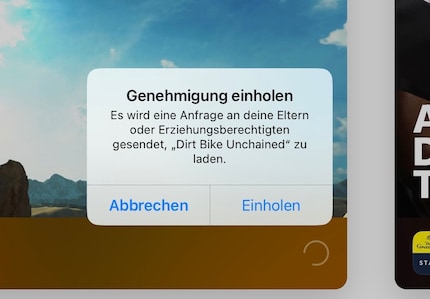
Gap in child protection: Stiftung Warentest sharply criticises Apple
Violent videos, gangsta rap or endless Candy Crush - children can do things on Apple devices that parents don't really want them to. Protection mechanisms are easy to circumvent, as research by Stiftung Warentest has shown.
Children should be able to use protected content with Apple devices. Parents can set up various parental control functions for this purpose. Thanks to appropriate restrictions, children should only be able to do with their iPhone or iPad what their parents have previously authorised. The controls have become increasingly sophisticated in recent years. For example, as a parent or guardian, you can define time limits for individual apps or limit spending in the App Store.
Where there's a will, there's a way. This also applies in Apple's ideal world of family permissions, parental controls and screen time. Stiftung Warentest - together with SWR - has discovered "significant weaknesses" in child protection (here to the report). Possibly nothing new for clever kids who have long known about and utilised these loopholes. The skills of digital natives should not be underestimated when it comes to circumventing restrictive functions.
Parent Pro tip: Regularly check the usage times of individual apps. If there are any anomalies, it's worth talking to your offspring about them and renegotiating limits if necessary.
Filter content by age? Doesn't work everywhere
Children don't even have to be particularly creative to access content that is not age-appropriate. The fact is that even with the filters activated, you can still find everything you don't want as a parent: torture scenes from horror films, rap videos with misogynistic lyrics, sexualised content, pictures and videos of accidents and other unpleasant content. The reason: The YouTube app doesn't really care about the age of the child stored on the Apple device and the content filters defined by parents. If your child surfs YouTube in incognito mode, the entire content on sale is basically open to them.
Apple explained in its statement that the filters set only apply to its own apps, for example Apple Music, Safari or Apple TV. However, developers of third-party apps could use the Apple interfaces to ensure parental control. This small but subtle difference between Apple apps and others is not made clear enough for Stiftung Warentest.
"If such an important restriction is not mentioned, many parents are likely to assume that Apple's parental control functions work in all apps installed on their child's device."
"Supported access" as a loophole?
The "Screen Time" function is nevertheless a good tool for parents, says Apple. This is probably true in the vast majority of cases. Parents can define that a gaming app can be used for longer at the weekend. To prevent chatting late into the night, use after 9 pm can be prevented. If your child doesn't like this parental paternalism, they can remove the restraints in "Supportive access". This function is actually made for people with cognitive impairments. When it is active, it displays larger app icons on the home screen, for example.
The great thing for children: in this mode, the Apple device has forgotten all the limits and restrictions that still apply in normal mode. Is this as easy as the critics at Stiftung Warentest claim? Apple disagrees. To activate the "Assisted Access" function, children would have to enter their parents' Screen Time password. Stiftung Warentest, on the other hand, claims that children can define any four-digit code themselves and even change it at any time.
I have tried this out - and cannot confirm Stiftung Warentest's experience. On our daughter's iPad, the parent PIN was required before switching to "Supportive Access". However, Apple says that "in some cases" this may indeed be the case, as criticised by the critics.
Close the gaps - or better talk about media use
In the media release on its research, Stiftung Warentest provides a whole list of recommendations on how parents can ideally set up Apple functions. The aim: maximum protection for children. For example, parents could prohibit the installation of new apps or set the usage time for certain apps to zero. Or, quite drastically, set up the child's iPhone completely in "assisted access" mode and only allow the apps they want. And if YouTube is a problem, for example, simply exclude it.

Source: Screenshot Apple
The better, adult way, however, would be to talk to the young users and make agreements. When is the child allowed to use the iPhone for what? After all, digital responsibility also needs to be learnt. And sometimes it helps when it's clear that neither iPhones nor iPads are allowed in bed.
What do you think about limits, filters and restrictions on smartphones and the like for children? Do you use Android? What's it like there? What experiences have you had? Let the Community know in a comment.
Journalist since 1997. Stopovers in Franconia (or the Franken region), Lake Constance, Obwalden, Nidwalden and Zurich. Father since 2014. Expert in editorial organisation and motivation. Focus on sustainability, home office tools, beautiful things for the home, creative toys and sports equipment.
From the latest iPhone to the return of 80s fashion. The editorial team will help you make sense of it all.
Show all